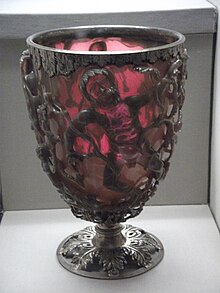Lycurgus Cup
 |
|
| Material | Glass, later gilt-bronze mounts |
|---|---|
| Size | Height: 15.8 cm (6.2 in) |
| Created | 4thC AD |
| Period/culture | Late Roman |
| Present location | British Museum, Room 41 |
| Identification | 1958,1202.1 |
The Lycurgus Cup is a 4th-century Roman glass cage cup made of a dichroic glass, which shows a different colour depending on whether or not light is passing through it; red when lit from behind and green when lit from in front. It is the only complete Roman glass object made from this type of glass, and the one exhibiting the most impressive change in colour; it has been described as "the most spectacular glass of the period, fittingly decorated, which we know to have existed".
The cup is also a very rare example of a complete Roman cage-cup, or diatretum, where the glass has been painstakingly cut and ground back to leave only a decorative "cage" at the original surface-level. Many parts of the cage have been completely undercut. Most cage-cups have a cage with a geometric abstract design, but here there is a composition with figures, showing the mythical King Lycurgus, who (depending on the version) tried to kill Ambrosia, a follower of the god Dionysus (Bacchus to the Romans). She was transformed into a vine that twined around the enraged king and restrained him, eventually killing him. Dionysus and two followers are shown taunting the king. The cup is the "only well-preserved figural example" of a cage cup.
The dichroic effect is achieved by making the glass with tiny proportions of nanoparticles of gold and silver dispersed in colloidal form throughout the glass material. The process used remains unclear, and it is likely that it was not well-understood or controlled by the makers, and was probably discovered by accidental "contamination" with minutely ground gold and silver dust. The glass-makers may not even have known that gold was involved, as the quantities involved are so tiny; they may have come from a small proportion of gold in any silver added (most Roman silver contains small proportions of gold), or from traces of gold or gold leaf left by accident in the workshop from other work. The very few other surviving fragments of Roman dichroic glass vary considerably in their two colours.
Corning Glass Works has reproduced a blank of a material of similar chemical composition and internal structure, which displays under reflected and transmitted light the same "Lycurgus effect" of green to red colour change as the Lycurgus cup material does.Cranberry glass or gold ruby glass is somewhat similar and far more common, manufactured with colloidal gold, but this only ever shows a red colour.
...
Wikipedia
